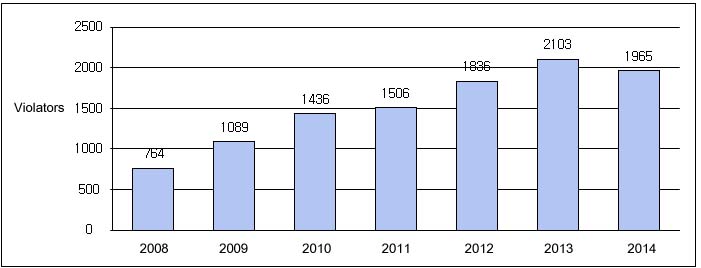Code of conduct violations in the public sector decreased by 6.6%
- Date2015-06-22
- Hit3,954
The number of public officials who violated the Code of Conduct for Public Officials in 2014 stood at 1,965, down 6.6% year-on-year. According to the ACRC, it was the first recorded drop in the number of the violators since the Commission’s launch in 2008.
The ACRC announced the results of its analysis of last year’s operation of the Code of Conduct for Public Officials, applicable to 312 organizations, including central and local governments and offices of education.
The Code of Conduct for Public Officials stipulates behavioral guidelines that must be observed by public officials. Any violator disclosed by the investigation of the ACRC or internal audit conducted by concerned organizations is subject to measures such as a caution, warning or disciplinary action.
The violators of the Code of Conduct in 2014 totaled 1,965, down 6.6% on the previous year. The number of violators in educational organizations dropped by 25.7%, while there was a big increase of 57.6% in metropolitan and provincial governments.
Number of persons who violated the Code of Conduct for Public Officials

1,234 persons (62.8%) were found to have violated the code of conduct by internal investigations, such as internal audits, while 731 violators (37.2%) were uncovered by external investigations conducted by the ACRC, the Board of Audit and Inspection, etc.
The highest proportion of internal investigation was recorded at the offices of education, 92.5%, followed by central government agencies, 58.7%. The figures were merely 31.1% and 34.5% at metropolitan/provincial and city/country government level respectively, suggesting that the self-correction capacity of local governments is relatively weaker.
By order of numbers of offenders, the greatest numbers were discovered in the category of "using budgets for unspecified purposes" (683 persons; 34.8%), "accepting money, gifts or hospitality" (655 persons; 33.3%), and "failure to report outside lectures" (209 persons; 10.6%). The three types accounted for 78.7% of the total.
"Using budgets for unspecified purposes" in particular showed a constant increase from 2010 to 2013, but recorded a significant drop of 30.1% year-on-year in 2014.
On the other hand, "failure to report outside lectures" saw a 45.1% rise. This, however, seems to be a transitional phenomenon as public organizations recently tightened their internal regulations on outside lectures according to the ACRC’s recommendation made in May 2012.
Furthermore, it was found that the ACRC’s recommendation made in April 2014 to strengthen punishment for those involved in corruption has contributed to strengthening punishment for public officials who violated the Code of Conduct.
In 2014, 15.4% of violators were subject to severe disciplinary action such as dismissal, up from 11.5% in 2013. Also, 56.4% of violators received comparatively softer punishments such as a caution or warning last year, down from 63.1% in 2013.
The ACRC plans to increase the effectiveness of the Code of Conduct for Public Officials whilst at the same time monitoring the implementation of the Code of Conduct by local governments more strictly.
The ACRC announced the results of its analysis of last year’s operation of the Code of Conduct for Public Officials, applicable to 312 organizations, including central and local governments and offices of education.
The Code of Conduct for Public Officials stipulates behavioral guidelines that must be observed by public officials. Any violator disclosed by the investigation of the ACRC or internal audit conducted by concerned organizations is subject to measures such as a caution, warning or disciplinary action.
The violators of the Code of Conduct in 2014 totaled 1,965, down 6.6% on the previous year. The number of violators in educational organizations dropped by 25.7%, while there was a big increase of 57.6% in metropolitan and provincial governments.

The highest proportion of internal investigation was recorded at the offices of education, 92.5%, followed by central government agencies, 58.7%. The figures were merely 31.1% and 34.5% at metropolitan/provincial and city/country government level respectively, suggesting that the self-correction capacity of local governments is relatively weaker.
By order of numbers of offenders, the greatest numbers were discovered in the category of "using budgets for unspecified purposes" (683 persons; 34.8%), "accepting money, gifts or hospitality" (655 persons; 33.3%), and "failure to report outside lectures" (209 persons; 10.6%). The three types accounted for 78.7% of the total.
"Using budgets for unspecified purposes" in particular showed a constant increase from 2010 to 2013, but recorded a significant drop of 30.1% year-on-year in 2014.
On the other hand, "failure to report outside lectures" saw a 45.1% rise. This, however, seems to be a transitional phenomenon as public organizations recently tightened their internal regulations on outside lectures according to the ACRC’s recommendation made in May 2012.
Furthermore, it was found that the ACRC’s recommendation made in April 2014 to strengthen punishment for those involved in corruption has contributed to strengthening punishment for public officials who violated the Code of Conduct.
In 2014, 15.4% of violators were subject to severe disciplinary action such as dismissal, up from 11.5% in 2013. Also, 56.4% of violators received comparatively softer punishments such as a caution or warning last year, down from 63.1% in 2013.
The ACRC plans to increase the effectiveness of the Code of Conduct for Public Officials whilst at the same time monitoring the implementation of the Code of Conduct by local governments more strictly.









